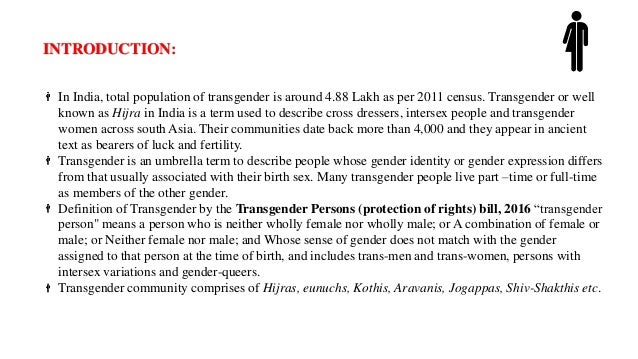Relevance: Sociology: Social classes in India: Issues of Minorities in India: & G.S paper I: Society and social issues
I. INTRODUCTION

Transgender community comprises of Hijras, eunuchs, Kothis, Aravanis, Jogappas, Shiv-Shakthis etc. Eunuchs have existed since 9th century BC. The word has roots in Greek and means “Keeper of the bed” castrated men were in popular demand to guard women quarters of royal households. Hinduism, Jainism and Buddhism – and it can be inferred that Vedic culture recognized three genders. The Vedas (1500 BC – 500 BC) describe individuals as belonging to one of three separate categories, according to one’s nature or prakrti.
These are also spelled out in the Kama Sutra (c. 4th century AD) and elsewhere as pumsprakrtistri-prakrti (female-nature), and tritiya-prakrti (thirdnature). Various texts suggest that third sex individuals were well known in pre-modern India, and included male bodied or female-bodied people as well as intersexuals, and that they can often be recognized from childhood.
A third sex is also discussed in ancient Hindu law, medicine, linguistics and astrology. The foundational work of Hindu law, the Manu Smriti (200 BC – 200 AD) explains the biological origins of the three sexes: “A male child is produced by a greater quantity of male seed, a female child by the prevalence of the female; if both are equal, a third-sex child or boy and girl twins are produced; if either are weak or deficient in quantity, a failure of conception results.
Indian linguist Patanjali’s work on Sanskrit grammar, the Mahabhaya (200 BC), states that Sanskrit’s three grammatical genders are derived from three natural genders. The earliest Tamil grammar, the Tolkappiyam (3rd century BC) also refers to hermaphrodites as a third “neuter” gender (in addition to a feminine category of unmasculine males). In Vedic astrology, the nine planets are each assigned to one
II. EVOLUTION OF TRANSGENDER COMMUNITY IN INDIA
Transgender persons had been part of Indian society for centuries. There was historical evidence of recognition of “third sex” or persons not confirm to male or female gender in near the beginning writings of ancient India. The concept of “tritiyaprakriti” or “napumsaka” had been an integral part of the Hindu mythology, folklore, epic and early Vedic and Puranic literatures. The term “napumsaka” had been used to denote the absence of procreative ability, presented by signifying difference from masculine and female markers.
Thus, some of the early texts extensively dealt with issues of sexuality and the idea of third gender which was an established thought therein. In fact, the Jain text even mentions the concept of “psychological sex”, which emphasized the psychological make-up of an individual, distinct from their sexual characteristics.
Lord Rama, in the epic Ramayana, was leaving in the forest upon being banished from the kingdom for 14 years, turns around to his followers and asks all the ‘men and women’ to return to the city.
Among his followers, the hijras alone did feel bound by this direction and decide to stay with him. Impressed with their loyalty, Rama sanctioned them the power to confer blessings on people on auspicious occasions like child birth and marriage, and also at inaugural functions which, it was supposed to set the stage for the custom of badhai in which hijras sing, dance and confer blessings. Aravan, the son of Arjuna and Nagakanya in Mahabharata, offer to be sacrificed to Goddess Kali to ensure the victory of the Pandavas in the Kurukshetra war, the only condition that he made was to spend the last night of his life in marriage. Since no woman was willing to marry one who was doomed to be killed, Krishna assumes the form of a beautiful woman called Mohini and married him. The Hijras of Tamil Nadu considered Aravan their progenitor and call themselves Aravanis.
III. HISTORICAL EVOLUTION OF TRANSGENDER COMMUNITY IN INDIA
Mughal Period Hijras played a famous role in the royal courts of the Islamic world, particularly in the Ottoman empires and the Mughal rule in the Medieval India. They rose to wellknown positions as political advisors, administrators, generals as well as guardians of the harems. Hijras were consider clever, trustworthy and fiercely loyal and had free access to all spaces and sections of population, thereby playing a crucial role in the politics of empire building in the Mughal era. The Hijras also occupied high positions in the Islamic religious institutions, especially in guarding the holy places of Mecca and Medina the person of trust, they were able to influence state decisions and also received large amount of money to have been closest to kings and queens. Thus hijra frequently state the role of their status in that period. British Period In the beginning of the British period in Indian subcontinent hijra used to accept protections and benefits by some Indian states through entry into the hijra community. Furthermore, the benefits incorporated the provision of land, rights of food and smaller amount of money from agricultural households in exact area which were ultimately removed through British legislation as because the land was not inherited through blood relations.
IV. CRIMINALIZATION UNDER THE COLONIAL RULE
Through the onset of colonial rule from the 18th century onwards, the situation changed drastically. Accounts of early European travelers showed that they were repulsed by the sight of Hijras and could not comprehend why they were given so much respect in the royal courts and other institutions. In the second half of the 19th century, the British colonial administration vigorously sought to criminalize the hijra community and to deny them the civil rights. Hijras were considered to be separate caste or tribe in different parts of India by the colonial administration. The Criminal Tribes Act, 1871, this included all hijra who were concerned in kidnapping and castrating children and dressed like women to dance in public places. The punishment for such activities was up to two years imprisonment and a fine or both. This pre-partition history influences the vulnerable circumstances of hijra in this contemporary world.
V. CRIMINALIZATION AND MARGINALIZATION DURING POST-INDEPENDENCE ERA
However the Act was repealed in 1952 and its legacy continues and many local laws reflected the prejudicial attitudes against certain tribes, including against Hijras. Recently, the Karnataka Police Act was amended in 2012 to “provide for registration and surveillance of Hijras who indulged in kidnapping of children, unnatural offences and offences of this nature” (Section 36A), in a similar vein to the Criminal Tribes Act,1871, According to Section 36A, Karnataka Police Act, 1964, Power to regulate eunuchs.
- preparation and preservation of a register of the names and places of residence of all eunuchs residing in the area under his charge and who are reasonably suspected of kidnapping or emasculating boys or of committing unnatural offences or any other offences or abetting the commission of such offences.
- Piling objections by aggrieved eunuchs to the inclusion of his name in the register and for removal of his name from the register of reasons to be recorded in writing.
VI. CONTEMPORARY PERIOD
The transgender in India is possibly the most well known and popular third type of sex in the modern world. The Supreme Court declared for transgender as third gender. The third genders in India have emerged as a strong faction in the LGBT rights. In the contemporary time the Government of India introduced so many welfare policy and schemes such as, census, documentation, issuing of the citizenship ID Cards, issuing passports, social-economical development and constitutional safeguards for the transgender people. The Mahatma Gandhi National Rural Employment Guarantee Act (MGNREGA) is a major initiative of the 11thFive Year Plan period which brought employment opportunities for transgender people. The Ministry of Housing and Urban Poverty Alleviation is the National Urban Livelihood Mission and Healthcare facilities. The social, economic, political transformation, Housing, legal measures, Police Reforms, legal and constitutional safeguards to prevent human rights violations of the transgender community and institutional mechanisms to address specific concerns of transgender people.
VII. CONCLUSION
Through, the transgender community was given high position in mughal period and facing many problems obstacles in British colonial rules. But now to safe guard the transgender communities there are many policy and schemes implemented by the government. Through this social economical status of the transgender community will be developed. The government should be eradicated the stigma, discrimination and human rights violation for the betterment of transgender community. If all this are brought in their day to day life, it would enlarge the growth of transgender community in India.
For more such notes, Articles, News & Views Join our Telegram Channel.
Click the link below to see the details about the UPSC –Civils courses offered by Triumph IAS. https://triumphias.com/pages-all-courses.php

